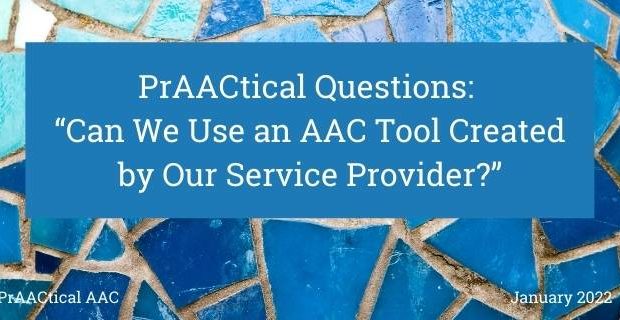PrAACtical Questions: “Can We Use an AAC Tool Created by Our Service Provider?”

In some areas of the country, professionals and school districts are creating their own no-tech AAC systems. These are usually focused on core vocabulary and are often fairly similar to things that are commercially available. There are several reasons that schools or clinical practices might create their own tools, such as having consistency across classrooms so that staff can learn the tool well and focus their efforts on strong implementation practices. Along with the advantages, there are a number of drawbacks to consider in your decision-making.
Here are some considerations in determining whether to use locally-created AAC materials.
- Examine the words that populate the system. Are the words, phrases, and/or sentences on their AAC tool a good fit for the learner in question?
- Look at the size of the vocabulary it offers. Are there enough words?
- Review the vocabulary layout to see how words are organized. Does it facilitate language growth? Does it make sense to the learner?
- Where does it lead?
- Communication skills develop over time, so it makes sense to consider what will happen when the AAC user is ready for more advanced language. AAC tools that don’t have a logical ‘next step’ can be problematic, particularly for individuals who learn fairly slowly. For them, locally-created AAC tools can be quite inefficient in the long run.
- This was the case for Ariana, who learned to use a set of communication boards created by the AAC professionals at her school district. It took 6-8 months for Ariana to begin using them effectively and she eventually used them quite well. Unfortunately, there was no ‘next step’ option, and when she needed a more robust system, Ariana had to learn a brand new kind of AAC tool. It was like starting over, in a way, which frustrated both Ariana and her team.
- Is there a technological counterpart? If the no-tech communication tool is built to look like an AAC app or software on a speech-generating device, we can offer that option when it seems appropriate to do so. If the communication board or book does not have a corresponding AAC app or SGD, the student will need to learn a different system in order to be able to use voice output communication aids.
- Communication skills develop over time, so it makes sense to consider what will happen when the AAC user is ready for more advanced language. AAC tools that don’t have a logical ‘next step’ can be problematic, particularly for individuals who learn fairly slowly. For them, locally-created AAC tools can be quite inefficient in the long run.
Have you had experiences with locally-designed AAC tools? We’d love to hear about them.
Filed under: Featured Posts, PrAACtical Thinking
This post was written by Carole Zangari
